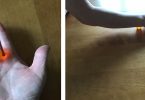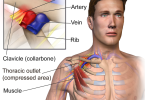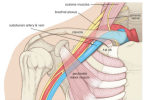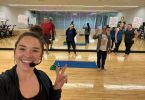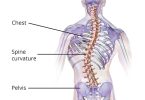Most people come for treatment of neck and shoulders because they carry tension in their shoulders. What’s really happening is the traps and neck are taking over for the lower trapezius muscles, which are underactive. These underactive muscles do not allow for proper use of the shoulder joint and can greatly affect your shoulder action in your sport. Here is an exercise to help activate these muscles to take the strain off the overworked upper trapezius …
Stand with feet hip-width apart. Let your arms hang at your sides and then slowly raise them up to shoulder height as if you are sleepwalking. Lower them and repeat several times. Did your upper arms and the top of your shoulder tense up?
Now, touch the bottom tip of your shoulder blade with your hand on each side. Remember that spot and think about drawing that tip towards your waist. Keeping that position, raise your arms up slowly again several times. Did your arms feel lighter? Did your upper arms and shoulders work less?
The muscles that kept your shoulder blade tips from riding up are the lower trapezius muscles. In the first version, you used your upper trapezius to hoist the arms up, and in the second you used your low trapezius to anchor your shoulder blades, stabilizing them and giving you better leverage.
Here is an exercise to help activate the lower trapezius muscles …
Sit comfortably on your sit bones. Reach back and feel the bottom tip of one of your shoulder blades and then feel the other one with the other hand. If you cannot reach back, you can look at them in a mirror or have someone else touch them. Remember where they are.
Now, draw the tip of one of them down diagonally towards your waist about half an inch, holding for less than a second and then relaxing. Now, draw the tip down repetitively with light pulsing actions. Repeat the same action with the other shoulder blade.
This is a coordination exercise. It builds a new memory of proper shoulder support in the brain.
Here’s another to activate your serratus anterior muscles …
Place a chair facing a wall and sit tall. Place your hands on the wall with the heels of your hands level with your armpits. Have your elbows slightly bent, aligning your middle fingers to the ceiling and spreading the other fingers away.
Lightly press your hands into the wall with a feeling that your hands and forearms are suspended from the wall. Let your elbows be heavy.
Paying attention to what is happening in your shoulders, start with letting the pads of your fingers sink into the wall. Picture the wall with padding and do not use more than an ounce of pressure.
Gently allow the rest of your hands to connect with the wall in this gentle way without any engagement in your shoulders. To activate your serratus anterior muscles, allow your last two fingers to grow longer. You should feel sensation in your shoulders travelling to your armpits and shoulder blades. Stay for several breaths.
Practicing these activation exercises every other day will allow proper shoulder movement for all your sports and daily activities.
By Gwen MacLean for Living Balance Clinic


